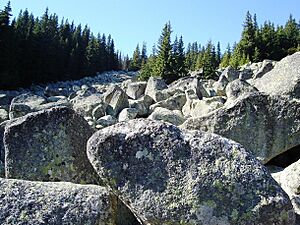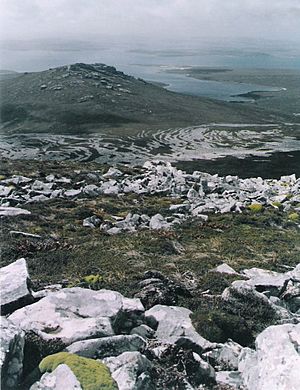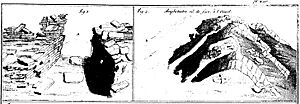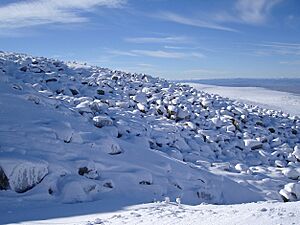Stone run facts for kids
A stone run is a special type of rock formation. It's also called a stone river, stone stream, or stone sea. Stone runs are created when rocks break down due to erosion. This happens because of repeated freezing and thawing in very cold, but not fully icy, conditions during the last Ice Age.
Five main things help create stone runs:
- Weathering: Rocks breaking apart.
- Solifluction: Wet soil and rocks slowly sliding down a slope.
- Frost heaving: Ice forming in the ground and pushing rocks up.
- Frost sorting: Rocks moving and sorting themselves by size due to freezing.
- Washing: Water carrying away smaller bits of rock.
Stone runs are different from moraines or rock glaciers. Moraines are piles of rock left by glaciers. Rock glaciers are like slow-moving rivers of rock. Stone runs, however, are made of rocks that are quite stable. This makes them safer to climb or walk across.
Stone runs are piles of large rocks with no small dirt or sand between them. In the Falkland Islands, they are found on slopes that are not very steep (between 1 and 10 degrees). They formed when the climate was much colder. They are always found with clay-rich soil that has moved slowly down slopes.
Contents
Where Do Stone Runs Form?
The Falkland Islands and Vitosha Mountain in Bulgaria have many large stone runs. These places had a special mix of cold weather and certain types of rocks during the Quaternary period. This is why stone runs formed there, but not in other places that might seem similar.
For example, the Falklands' climate today is like Scotland's. But during the Ice Age, Scotland was completely covered by glaciers. This meant stone runs could not form there. Also, other southern areas with similar cold histories, like Tierra del Fuego, don't have stone runs because their rocks are different.
Vitosha Mountain in Bulgaria is quite small, about 15 km by 10 km. But it has many stone runs, along with other rock formations like screes (piles of broken rocks). This shows that having the right cold conditions and rock types is important, but not the only thing needed for stone runs to form.
You can also find smaller stone runs in other places. These include England (like at the Stiperstones in Shropshire) and Pennsylvania in the USA. They are common where slow-moving soil deposits contain many strong, frost-resistant rocks.
Falkland Islands' Stone Runs
The stone runs in the Falkland Islands are made of very hard quartzite rocks. They are bigger and more common on East Falkland, especially near the Wickham Heights. Some of these are over 5 km long! On West Falkland and smaller islands, they are fewer and smaller.
One famous stone run is called "Princes Street Stone Run." It was first called "great valley of fragments" by Charles Darwin. It's about 4 km long and 400 m wide. It's located about 20 km northwest of Stanley.
Early Discoveries of Falklands' Stone Runs
One of the first people to describe the Falklands' stone runs was Antoine-Joseph Pernety. He explored the islands in 1763-64 with a French expedition. He wrote about two amazing stone features he called 'City Gates' and 'Amphitheatre':
We were no less astonished at the sight of the infinite number of stones of all sizes thrown one upon another, and yet ranged as if they had been piled negligently to fill up some hollows. We admired with insatiable delight the prodigious works of Nature.
Young Charles Darwin visited the Falklands in 1833 and 1834. He continued Pernety's observations:
Pernety has devoted several pages to the description of a Hill of Ruins, the successive strata of which he has justly compared to the seats of an amphitheatre. (...)
In many parts of the island the bottoms of the valleys are covered in an extraordinary manner by myriad great loose angular fragments of the quartz rock, forming "streams of stones." These have been mentioned with surprise by every voyager since the time of Pernety. The blocks are not waterworn, their angles being only a little blunted; they vary in size from one or two feet in diameter to ten, or even more than twenty times as much. They are not thrown together into irregular piles, but are spread out into level sheets or great streams. It is not possible to ascertain their thickness, but the water of small streamlets can be heard trickling through the stones many feet below the surface. The actual depth is probably great, because the crevices between the lower fragments must long ago have been filled up with sand. The width of these sheets of stones varies from a few hundred feet to a mile; but the peaty soil daily encroaches on the borders, and even forms islets wherever a few fragments happen to lie close together. In a valley south of Berkeley Sound, which some of our party called the "great valley of fragments," it was necessary to cross an uninterrupted band half a mile wide, by jumping from one pointed stone to another. So large were the fragments, that being overtaken by a shower of rain, I readily found shelter beneath one of them.
Their little inclination is the most remarkable circumstance in these "streams of stones." On the hill-sides I have seen them sloping at an angle of ten degrees with the horizon; but in some of the level, broad-bottomed valleys, the inclination is only just sufficient to be clearly perceived. On so rugged a surface there was no means of measuring the angle; but to give a common illustration, I may say that the slope would not have checked the speed of an English mail-coach. In some places, a continuous stream of these fragments followed up the course of a valley, and even extended to the very crest of the hill. On these crests huge masses, exceeding in dimensions any small building, seemed to stand arrested in their headlong course: there, also, the curved strata of the archways lay piled on each other, like the ruins of some vast and ancient cathedral. (...)
These scenes are on the spot rendered more striking by the contrast of the low, rounded forms of the neighbouring hills.
Vitosha Mountain's Stone Rivers
The stone rivers on Vitosha Mountain in Bulgaria are found high up, over 1,000 meters above sea level. Some of the biggest ones are near the highest peak, Cherni Vrah (2290 m). They also appear in the upper parts of the mountain's rivers.
One famous site is Zlatnite Mostove ('Golden Bridges'). Here, a stone river stretches over 2 km long! Other stone rivers, like those in the Boyanska, Bistritsa, and Struma river valleys, are over 1 km long. The 'Golyamata Gramada' (Big Pile) Stone River in the Vitoshka Bistritsa River valley is up to 300 m wide. Some of the rocks are huge, weighing hundreds of tons!
Vitosha Mountain was known even in ancient times. But its first modern geological survey was done in 1836 by Ami Boué. For many decades, scientists argued about whether Vitosha's stone rivers were true glacial moraines. Eventually, they agreed they were not.
In the past, people used the rocks from these stone rivers to make cobblestones for the streets of Sofia. Today, these stone rivers are protected by law. Sometimes, special permission is given to remove a few rocks for sculptures.
Vitosha is a nature park located right next to Sofia. It's a very popular place for tourists. About 1.5 million people visit the mountain every year, and the stone rivers are a major attraction.
Images for kids
-
Stone run at Mount Kent, East Falkland
See also
 In Spanish: Río de piedra para niños
In Spanish: Río de piedra para niños







